Here are some common types of outdoor play equipment
2023-12-28
Outdoor play equipment refers to a variety of structures and items designed for children to use and interact with in outdoor spaces. These play structures are essential for promoting physical activity, social interaction, and imaginative play. Here are some common types of outdoor play equipment:
1. Swings:
- Swing sets are classic outdoor play structures that usually consist of swings suspended from a frame. They come in various designs, including single swings, tandem swings, and tire swings.
2. Slides:
- Slides are inclined surfaces that children can slide down. They can be standalone structures or part of a larger play set. Some slides are straight, while others may have twists or turns.
3. Climbing Structures:
- Climbing structures encourage physical activity and motor skill development. They may include climbing walls, cargo nets, rope structures, and jungle gyms.
4. Playhouses and Forts:
- Playhouses and forts offer children a space for imaginative play. These structures may have windows, doors, and even accessories like kitchenettes or chalkboards.
5. Sandboxes:
- Sandboxes provide a designated area for children to play with sand. They often have built-in seats or ledges and may come with covers to keep the sand clean.
6. Water Play Equipment:
- Water tables, splash pads, or small wading pools can be part of outdoor play equipment, especially during warm weather. These items allow children to engage in water play while staying cool.
7. See-Saws or Teeter-Totters:
- See-saws provide a rocking motion as children shift their weight back and forth. They often come in pairs to accommodate two children at a time.
8. Balance Beams:
- Low balance beams or stepping stones are designed to enhance balance and coordination skills. They can be arranged in various patterns to create a challenging course.
9. Basketball Hoops:
- Basketball hoops, often adjustable in height, are suitable for older children and provide an opportunity for sports play.
10. Spring Riders:
- Spring riders are individual ride-on structures mounted on springs. They come in various shapes, such as animals, cars, or motorcycles, and provide a bouncing motion.
11. Tunnels:
- Tunnels, either standalone or part of a larger play structure, can be crawled through or used for hide-and-seek activities.
12. Outdoor Musical Instruments:
- Some play areas incorporate outdoor musical instruments like drums, xylophones, and chimes, allowing children to explore sound and rhythm.
13. Tire Swings:
- Hanging tire swings provide a different swinging experience and can be a fun addition to a play area.
When selecting outdoor play equipment, it's important to consider factors such as the age of the children, available space, safety features, and the durability of materials. Additionally, proper installation and regular maintenance are crucial to ensure the safety and longevity of the play equipment.



